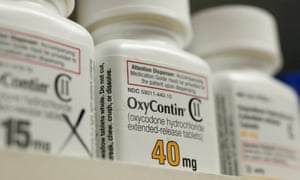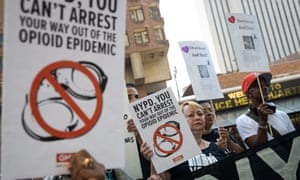Deborah Fuller had just heard the sentences that were the closest she would get to justice.
In March 2016, her daughter Sarah died from an overdose of drugs that included Subsys: a tiny yet potent spray containing fentanyl, an opioid 50 to 100 times stronger than morphine. The day before her death, mother and daughter had chatted about her upcoming wedding. Sarah had already bought a garter. Deborah was planning to sew her veil.
---
The next morning, Sarah’s fiancé found her dead, keeled over on her face. “It was not a vision I would wish on anyone. We had to have her cremated because there was no way they could have made it so that she was recognisable,” Deborah recalls in an interview.
The former nursing assistant had first become addicted to opioids when she was prescribed them for fibromyalgia and neck and back injuries. After she recovered from the addiction, she visited a new doctor. With an Insys sales representative in the room, she was put back on opioids including Subsys — and within 20 days, her dose of the spray was tripled. Admitted to hospital for hyper-sedation, physicians recommended she stop using the spray — but her doctor continued to prescribe it.
Now, four years later, executives from Insys, the maker of Subsys, had become the first pharmaceutical bosses to be handed prison time for their role in America’s opioid epidemic. Clutching her speech, the 62-year-old mother from New Jersey stood outside the court in Boston this January and accused John Kapoor, the Insys founder, and his colleagues of a “greed and fraud” that took Sarah away when she was just 32. “They are no different from mobsters,” she said.
Seven of the Insys executives and employees on trial were found guilty of masterminding and participating in a scheme to bribe doctors to prescribe the drug. Kapoor was sentenced to five and a half years on charges that included racketeering conspiracy. Michael Babich, Insys’ former chief executive, and Alec Burlakoff, former vice-president of sales, co-operated with prosecutors and received two and a half, and 26 months, respectively.
Fuller calls the sentences “a disgrace”, believing they should have been far longer. But she hopes the sheer fact of people going to prison will deter other drugmakers, which may have previously accepted fines as a cost of doing business. “Normally, they just get a slap on the wrist and have to pay a penalty, which was easily made up by selling more opioids,” she says. “At least now, they’ll have to think, maybe they’ll go to jail for this.”
---Also Watch
----
The opioid epidemic has shaped America. There have been 750,000 overdose deaths since the crisis began in 1999, according to the Centers for Disease Control and Prevention, and about two-thirds involved an opioid. Fuller’s family is one of many still suffering from losing a loved one.
Many people hooked on illegal opioids start on painkillers prescribed by doctors. At first, marketers convinced some physicians that opioids were not as addictive as previously thought. But in some regions, the abuse became brazen. One town in West Virginia had 3,200 residents, but was receiving enough opioids for them to take 6,500 pills each over 10 years.
In a joint investigation between the FT and the PBS series Frontline, we spoke to several former employees about life inside Insys, including Burlakoff, the former vice-president of sales, who we questioned under prosecutors’ supervision. We also interviewed prosecutors, short sellers and the reporters who exposed the scheme.
Insys was a flagrant flouter of the rules. Founded in 2002, it started clinical trials for its under-the-tongue fentanyl spray in 2007. Subsys won regulatory approval in 2012, more than a decade into the opioid crisis, when overdose deaths were already rising and after other pharma companies had been fined for mismarketing opioids.
The company used tactics familiar in the US pharmaceutical industry — but took them across the line into illegality. Many drugmakers pay speakers’ fees to doctors, with the understanding that they will recommend their product to peers at educational events — but Insys made it clear that they expected more prescriptions in return for their money. Sometimes it abandoned the pretence of such events completely.
Subsys was approved for “breakthrough” bursts of pain in cancer patients already tolerant to opioids, yet the majority of prescriptions were for patients, like Fuller, who did not even have cancer. It is legal and common for doctors in the US to prescribe drugs “off label” or for uses they are not approved for. But it is illegal for pharmaceutical companies to market their medicines for these other uses.
Jerry Avorn, who heads the division of pharmacoepidemiology at Brigham and Women’s Hospital in Boston, believes it was mostly the marketing to doctors that made Subsys “lethal”. “The Insys example is the extreme . . . ‘mass shooter’ version of what happens when you create a culture that does not pay enough attention to what’s true and what isn’t about drugs, and where you allow uncontrolled marketing,” he says. “What made it so dangerous was people getting behind it and seeing it as a ticket to riches.”
The pharmaceutical industry has a history of paying settlements in the billions of dollars. But even as evidence of investigations began to emerge, analysts played down the risks, sometimes citing companies that had previously only received fines, and investors bid up the stock.
Across the US, counties and states are now suing pharmaceutical companies, desperate to recoup the cost of treating and policing those hooked on their drugs. Many of the defendants have teamed up to offer $48bn to settle these suits — but so far, many states are holding out for more. After all, according to the Council of Economic Advisers, the crisis cost the country $2.5tn from 2015 to 2018.
“Most people involved in making opioids, distributing them and financing the companies turned a blind eye as at first there were thousands of deaths, then tens of thousands, and then hundreds of thousands of deaths. These are the kind of numbers we usually associate with genocides and civil wars — in the richest country in the history of human civilisation,” says Anand Giridharadas, author of Winners Take All, a critique of how elites make their money. “There’s now a mountain of evidence about all the people who had warning signs who ignored them.”
---
At the end of 2013, Insys chief executive Michael Babich was lauded on CNBC. The stock was the best performing initial public offering of the year — up by more than 400 per cent at its peak — and sales had risen almost sevenfold year-on-year. The TV anchor served up a softball: “Tell us what it is about Insys that has investors so excited?”
Wearing a tightly buttoned gingham shirt, Babich showed off the Subsys spray, smaller than an asthma inhaler. He blinked rapidly as he trotted out the official line: the product is designed for cancer patients suffering from “breakthrough” bursts of pain.
Wall Street was captivated by the numbers coming out of the small Arizona-based company — and downplayed risks it could not quantify. The Wall Street Journal praised Babich that year as “the right kind of insider trader” for legally buying more stock to show his conviction in Insys. Insys founder, John Kapoor, originally from India, cast himself as an immigrant success story, telling Forbes: “This is the country you can do it in. Nowhere else.”
David Amsellem, a softly spoken analyst at Piper Sandler with decades of experience covering pharmaceuticals, recommended buying Insys in 2014. Speaking in a conference room above New York’s Park Avenue, he described how he and fellow analysts were impressed that sales were taking off, when most small biotech companies spend years investing in R&D before selling anything. “Insys was a rare breed as a company that had a product that was on the market,” he says. “In other words, it wasn’t just a hope and a dream.”
For Stephanie Yon, however, Insys was a nightmare. That December when Babich was promoting the fentanyl spray on TV, the Michigan mother of three started seeing Dr Gavin Awerbuch, seeking treatment for pain from a car crash the month before. Yon did not have cancer. She had not taken opioids before. Subsys came with a “black-box warning” that it could cause respiratory depression and death. Yet Awerbuch prescribed her a plethora of opioids, including Subsys. Then, he increased her dose rapidly. The 38-year-old died on March 14 2014, just three months after the initial prescription, with lethal levels of fentanyl in her body.
Brian McKeen, the lawyer for Yon’s family, says no one could have mistaken the drug as safe. “It doesn’t happen because of a lack of scientific knowledge, or a lack of warning. It happens because of doctors disregarding patient safety and putting their own financial interest first,” he says.
Unbeknown to Yon, her doctor had such a close relationship to Insys that the company’s management would advise sales reps across the US to get their own Awerbuch. He was the top prescriber of Subsys in the country, helping fuel sales that rose 276 per cent year-on-year in the first quarter of 2014. In return, his pockets jangled with so-called “speakers’ fees”: in 18 months, he was paid $138,000, ostensibly for educating other medical professionals about the drug. The local press reported that much was spent on his vast collection of ancient coins.
At the trial last year, Awerbuch described searching his files for new patients to write Subsys prescriptions for. “It got to the point — and this was a complete lack of judgment on my part, but I started prescribing Subsys to patients who really didn’t need such a potent medicine,” he said. “I probably went against my Hippocratic oath and did prescribe medicine that could potentially harm patients.”
He liked the money and the Insys reps, who made him feel like they were his friends. Many were hired for their beauty — Burlakoff says he knew that “sex sells” — and few had deep experience in pharmaceuticals. “Honestly, they had beautiful sales reps, and I liked the attention I was getting,” Awerbuch testified. Two months after Yon died, he was arrested. He pled guilty and was sentenced to 32 months in prison and forced to pay restitution and fines of $4.1m.
“When you have a prescriber who can say, ‘I was bribed,’ that’s an important moment,” says Nat Yeager, who prosecuted the Insys executives. But inside the company, Burlakoff claims, no one cared. In fact, the sales representative who courted Awerbuch was promoted. Asked about the case on an earnings call, Babich insisted: “In no way, shape or form was there any allegations against Insys” [sic].
Amsellem, the Piper Sandler analyst, says Insys leaders were “very, very clear” that the doctors who were arrested were just “bad actors”. “Basically, I had to take management’s word for it. And there’s always going to be that element of trust,” he says. “You want to believe that management teams are going to be honest.”
The stock carried on rising.
Giridharadas says Wall Street funded the opioid crisis, just like it speculated its way into causing the financial crisis. “The system is set up to tell corporations to make as much money as possible by cutting every possible societal corner,” he says. “It is a sector of our society that is consistently working in advocating against the life, liberty and pursuit of happiness of the American people.”
---
A year later, Insys sales representatives were revelling in their success. Sales in the first quarter of 2015 soared more than 70 per cent year-on-year, and the stock was climbing towards its peak that July, at almost six times the IPO price. At a national sales conference in Arizona, reps showed off a video that was later to become an exhibit at trial. Parodying a hit by hip-hop artist A$AP Rocky, the sales reps rapped: “I love titration. Yeah, that’s not a problem. I got new patients, and I got a lot of ’em.”
The lines referred to the tactics used by sales reps of pressuring doctors to escalate patient doses of Subsys — known as titration. Higher doses fetched higher prices, and so the reps pocketed fatter commissions. In the video, a man in a giant Subsys costume dances with the rappers. At the end, Burlakoff comes out from under the costume. The audience laughed and clapped, one former sales representative told the FT and PBS Frontline. They had no idea that it would be “a piece of evidence in court in four or five years’ time,” he says.
Our team interviewed Burlakoff last summer, before he was sentenced, under the supervision of the prosecutors at a studio in Boston. Wearing the smart suit of the salesman he once was, he was extremely talkative. Just as he had decided to “co-operate like nobody’s business” with the prosecutors, he was eager to recount how Insys devised its scheme. “I didn’t think about the patients, the people suffering, the addiction,” he admits. “I imagined that I was selling a widget.”
He described how he was in awe of the billionaire Kapoor and set about creating a team that would recruit doctors who, nine times out of 10, were not oncologists. “It all comes down to targeting. You gotta find their hot button. Whatever makes them tick. And it sounds ruthless and it is ruthless that we would target someone that is in distress in an effort to take advantage of them,” he says. Sometimes the target was wooed more literally. “Sex with a doctor or chartering a private jet and taking a couple of doctors to, say, Cancún, Mexico. It’s been done,” he says.
The criminal conspiracy went right to the top. While many pharmaceutical companies pay speakers’ fees to doctors, they don’t officially expect them to prescribe more of their drug. Kapoor insisted on a clear return on investment. “Dr Kapoor doesn’t lose. He made that very clear. He did not want to lose a penny,” Burlakoff recalls. Insys sales representatives were instructed to deliver at least a 2:1 return. “The only way that I knew how to do it, to get that guarantee, is to bribe doctors.”
This clarity was to prove the company’s downfall. Prosecutors discovered a spreadsheet — which they dubbed a “smoking gun” — that showed calculations of the return Insys was getting from its investment in speakers’ fees. Insys also deceived insurers so they would pay for prescriptions. The company created an internal reimbursement centre, giving staff carefully worded scripts known as “The Spiel” that would convince insurers to pay up, often by implying — or even claiming — that a patient had cancer when they did not.
Fred Wyshak, one of the prosecutors, said in an interview: “Kapoor decided that, ‘If I’m paying doctors to speak, I’m also paying them to write [prescriptions].’ And philosophically, that’s not supposed to be the way it works. I’m not saying that’s not the reality in the pharmaceutical industry, and as I think Burlakoff described it, that’s the dirty little secret in the pharmaceutical industry, but nobody ever discusses it.”
Wyshak had built his career prosecuting the mafia. He used similar tactics to turn witnesses and unearth evidence to prosecute Insys leadership. Kapoor was the ultimate target. “The executives at Insys displayed an arrogance that you find in organised crime groups,” he says. “They thought that they were above the law.”
---
Short sellers, who search for stocks they think will fall and profit if they do, were also digging into Insys. They believed that Wall Street was missing warning signs. Jim Carruthers, who runs his firm Sophos Capital from Silicon Valley, became suspicious because there were so few doctors prescribing so much Subsys. Carruthers had shorted healthcare companies before and began to piece together public data including which doctors Insys was paying, available under transparency laws, and the numbers of overdoses related to the drug. He also hired a private investigator, who visited a top prescriber in Alabama, describing it as the “epitome of a pill mill”.
“We thought this was all information that when it came out into the public market, that would change the investors’ perception of the value of the stock,” Carruthers says. His “aha moment” came when his firm approached someone who used to work for Insys competitor Cephalon. It turned out the employee also used to work for Insys. “When we asked him why he left that name off his résumé he told us, ‘Because these guys are all going to get arrested. They’re all going to go to prison,’” he says.
Carruthers built his short position and sent tips to journalists. In April 2015, Roddy Boyd, a hedge-fund analyst-turned-investigative reporter in North Carolina, published an exposé, “Insys Therapeutics and the New ‘Killing It’” on his non-profit site, called The Southern Investigative Reporting Foundation at the time. The stock fell almost 10 per cent. Within weeks, though, it had recovered. Carruthers says the “greed” went beyond the top of Insys, down to its investors. “There were people on Wall Street who were intent on keeping this stock price up and, I believe, ignoring some of the more obvious indications that this was an unsustainable, potentially fraudulent business model,” he says.
Amsellem says the first reports of investigations into Insys were met with a “collective shrug”. “There had been a whole host of investigations of other companies, companies that are industry leaders and big fines that were paid. And none of these companies were put into bankruptcy,” he says.
When David Steinberg, an analyst at Jefferies, initiated coverage of the stock as a “buy” in late 2014, he acknowledged the investigations could bring “more negative headlines”. “As we are not privy to the facts, we are not in a position to render a conclusion. That said, we’re pretty sure that the worst case outcome for Insys is some sort of fine,” he wrote. The fact that investors assumed investigations could be settled for a fine was understandable. There was no precedent for pharmaceutical executives being sent to jail. Purdue Pharma, owned by certain members of the Sackler family, had settled a 2007 misbranding case of its opioid OxyContin for $600m. Cephalon, which also sold a fast-acting fentanyl product Actiq and had previously employed Burlakoff, settled investigations into its marketing practices in 2008 for $425m.
“If Cephalon executives had gone to jail for the way they promoted Actiq, for actions they took that promoted a loss of life, then maybe we wouldn’t have had a Subsys,” says Andrew Kolodny, co-director of opioid policy research at the Heller School for Social Policy and Management.
In late 2015, more heavy prescribers of Subsys were arrested and the company began to suspect federal agents were pursuing executives. And yet, in 2016, five out of the six analysts covering the stock still had “buy” or “outperform” ratings on it. Some analysts kept buy ratings on Insys until shortly before it went bankrupt in 2019, according to Sinan Gokkaya, an associate professor of finance at Ohio University. “Short sellers have an incentive to push down the price so they can get involved in negative investigations,” he says. “If I’m an analyst, I don’t have much to gain from a negative stock price.”
In May 2017, Amsellem became the second to downgrade Insys, rating it “neutral”. He did not rate it as “underweight” until March 2018, five months after Kapoor had been arrested and charged. Amsellem says he wanted to keep his focus on “data and information”. By 2018, investigations had made doctors more cautious about prescribing any fast-acting fentanyl drug. Subsys sales were lower than they had been at the initial public offering in 2013.
“I don’t regret not downgrading it earlier,” he explains. “I think that to make decisions on stocks you have to be methodical . . . You don’t want to be knee-jerk. Does that mean that sometimes you might get things wrong? Yes. I get things wrong all the time in terms of stockpicking.”
---
If you google “Subsys”, you will find, perhaps surprisingly, that the tiny fentanyl spray is still on the market in the US. After executives were convicted and Insys was ordered to pay $225m to the US government, the company filed for Chapter 11 bankruptcy in June 2019. Subsys was sold to Wyoming-based BTcP Pharma, in return for paying a proportion of sales to creditors. Several state attorney-generals objected. The Maryland attorney-general argued there were “ample red flags” about the new owner. “Patients became addicted to Subsys through Insys’ misconduct and their addiction has not been treated; the court should ensure, in approving any sale, that Subsys will not fall into the hands of those who would further exploit that addiction through intentional conduct or negligence,” the objection read. “Further harm should not emerge from this bankruptcy.” The sale was approved after BTcP promised to only market it for cancer patients. BTcP’s parent company did not respond to a request for comment.
Insys was an extraordinary case of explicit bribery to prescribe a potent opioid — and an unusual example of government agencies rallying together to prosecute executives. But it also exposed flaws in how the US regulates drugs. The system makes it hard to catch bad actors — whether individuals or entire companies — before they devastate lives.
Chris McGreal, author of American Overdose, says it took the FDA 20 years to improve its monitoring of whether a drug is addictive. “One of the strongest and most constant criticisms of the FDA during this epidemic is that it’s taken a very narrow view of the grounds on which it approves a drug,” he explains. “They don’t want to know the answer to the question, is this drug addictive and therefore dangerous? Will it kill patients?”
Since Subsys came on the market in 2012, the regulator has put new warnings on the boxes of opioids and required companies to do studies into misuse and overdose after approval. It has requested that one opioid — Opana ER, made by Endo Pharmaceuticals — be removed from the market because of patterns of abuse, but also approved Dsuvia, by AcelRx Pharmaceuticals, another fast-acting opioid, despite strong criticism.
Yet off-label prescription is still rife. Sometimes it makes sense to give doctors discretion, but it can also be dangerous: concerns have been raised about the effects of anti-psychotics prescribed for dementia, which ended up increasing death rates, and antidepressants that raise the risk of suicide in children and adolescents.
Aaron Kesselheim, a professor at Harvard Medical School, believes the FDA needs to invest more in monitoring drugs after they have approved them. He fears recent court cases have given pharma companies more — not less — latitude in how they market drugs off-label. “Things are moving in the wrong direction,” he says.
The Physician Payment Sunshine Act of 2010 put data on doctors taking dollars online. But it would take an enterprising patient to discover it — and decipher what it might mean for their care. And transparency has not stopped many doctors from taking the money. A 2019 paper in the journal Addiction analysed data from more than 800,000 physicians and found those who received money from opioid makers tend to prescribe substantially larger quantities of opioids.
---
The US is now consumed by another public health disaster. Yet the coronavirus pandemic could end up exacerbating the opioid epidemic. A report from the Well Being Trust, a foundation focused on mental health, predicted “deaths of despair” from suicide, drug and alcohol abuse, could rise because of Covid-19, leading to another 75,000 deaths. Lawsuits against other opioid makers have been delayed by lockdowns. There are civil suits against much larger companies including Johnson & Johnson and Teva, as well as distributors and pharmacies. Attorney-generals are pursuing certain members of the Sackler family in relation to Purdue Pharma, but those cases are on hold as part of the bankruptcy process. There are also signs of a criminal investigation, with opioid manufacturers being hit with subpoenas. The companies and members of the Sackler family all deny any wrongdoing.
Wall Street analysts do now say that litigation risks are affecting their ratings. But they still view the potential fines as a financial calculation. As news has trickled out about possible settlements, they have tried to look for bright sides. One wrote that the deal would likely be less than the $248bn the tobacco industry settled for in 1998, because there have been fewer deaths from prescription opioids than there were from smoking. Another called possible fines “manageable” for J&J, which is the world’s largest healthcare company.
Meanwhile families such as the Fullers live with their loss every day. Deborah says the end of the year is always a slog: Sarah is missing from Thanksgiving, then her birthday, then Christmas. “We haven’t decorated for Christmas in some time,” she says. “Within a very short period of time, there are all these family-oriented holidays, when one fourth of our family is not here any more.” She hopes the Insys case will be a warning to other drugmakers — but she also believes the broader system needs to change. It should be far harder to prescribe medications off-label, especially dangerous opioids, she says. Doctors should be cautious about taking money from pharmaceutical companies, and, if they do, they should be forced to declare it “in a frame in big letters in their office”.
“They take an oath not to hurt anybody,” she says. “When your patients are dying . . . that goes beyond hurting.”




